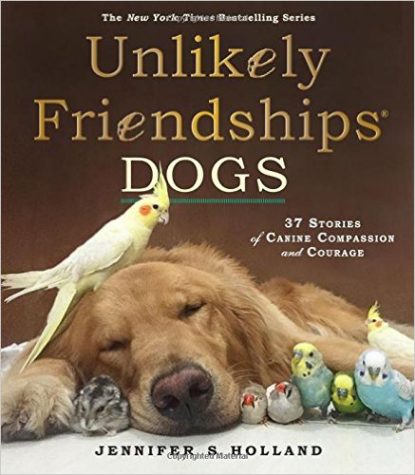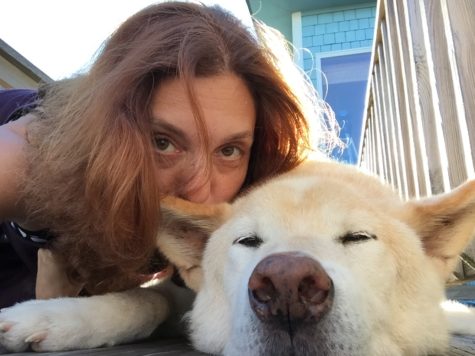
Ann: Jenny has a new book out. It’s part of a series — best-selling, mind you — about unlikely relationships between animals and surprising animal heroics. (This one is called Unlikely Friendships: Dogs. It has a lot of dogs in it.) So far, I’ve read only the Amazon Read-Inside story about the dog and the goose, which I’ll sum up as: dog is bone-mean and slated for termination, given one last chance, nearly blows it, meets goose that’s just as mean, they become life-long friends for a year and a half, goose dies, dog mourns. First, let me say, for what it’s worth, that I believe the goose story. I grew up on a small farm and if you somehow pissed off the geese, they’d attack. By “attack,” I mean, wings fully spread, neck stretched out, hissing like a steam engine, coming at you at 90 mph. I’d put a goose up against a German shepherd any day. I digress: that hate-love-death plot is the plot of many excellent novels and films. So my question is not whether you think you’re anthropomorphizing, but how you handle the inevitable anthropomorphizing?
Jenny: Well howdy, Ann! Thank you for sharing your terrifying goose experience, and for your excellent question. For this series of books (the Unlikely series…a name that for me works on so many levels) I’d say I walk a fine line, one that I do toe over now and then as the stories and photos beg me to. But I am big on qualifying and letting others tell me what they think is going on with their animals rather than me making wild assessments. This series makes people go awwwww; it doesn’t promise a lot of neuroscience. Readers just want to enjoy the cute photos and stories without being asked to question their assumptions.
Ann: What is it with people and their animals? People who talk about their animals as their honest-to-God children? People who talk as though animals and people are the same species and animals’ reference frames are the same as peoples’ reference frames? Do these people seem to you to go beyond anthropomorphizing?
Jenny: I kind of get those people, being a person without children (and a big animal lover) myself, though I do view humans and nonhumans as different animals with different perspectives. Some people take the pet thing to a whole different level, one that might seem distasteful or just plain ridiculous to others. But hey, who are we to judge? As long as the animals are treated humanely, it doesn’t really bother me if an owner wants to gush over her “widdle baby fuzzy muffin” and push it around in a baby stroller. It makes people happy to love their animals that much, so try not to gag at the image. Happy people, the ones with their pet’s faces printed on their sweatshirts, are more likely to let you butt in line at the airport.
Ann: I’m all in favor of happy people and happy animals — have at it, then, that’s what I say. But what does science say about animal having thoughts and feelings?
Jenny: The research is showing a lot of overlap in emotional capabilities between, say, dogs and people. All mammals have the same emotional center in the brain, so it makes a lot of sense. We know elephants mourn and feel empathy. Rats and pigs get very upset if a buddy is in pain, so there appears to be empathy there, too (or else the shrieking just hurts their ears). And dogs, of course, show that ability.
Ann: I even knew that about the pain; I looked it up for a post on empathy. It makes you wonder about the difference between empathy and love.
Jenny: Agreed! Maybe it’s just a continuum of sorts. Does an animal love the same way we do? Maybe not. Instinct and hormones can look like emotion (e.g., a lactating mother animal taking in an orphan). In dogs, there’s a rise in oxytocin that accompanies a “loving” gaze, just as there is in us: For the animals it may be an evolutionary “strategy” (for lack of a better word) to elicit care. But so what? How it is different from what a baby does to get our attention? Meanwhile, the desire for companionship is real, as is the loyalty to the one who is loving in return. (Not that the other stuff isn’t real. It’s confusing, no?)
Ann: It’s confusing, yes. I hadn’t really thought about about the parallel between babies’ reactions and animals’. Not only confusing, maybe a little uncomfortable. But at least AT LEAST we’re smarter than they are.
Jenny: Yes. Most of us. (I know a few people…well…let’s not go there.) But nonhuman animals aren’t robots–they’re strong learners. Very new research shows dogs get a lot of info from tone of voice and other subtleties, and respond accordingly. And they can learn vocabulary like a two-year-old child.
Ann: So dogs are a little comparable not only to babies but to two-year-olds? I’m serious, this is seriously disorienting.
Jenny: Maybe you need to get a dog (they smell better than toddlers). The science is catching up to the crazy animal lovers like me who already believed that other mammals have higher intelligence than we once thought as well as more complex emotions. (Although no, your dog probably won’t actually feel guilty about eating your $180 Manolos. He just won’t like being yelled at.)
Ann: I am happy now that I have neither dog nor Manolos, and I never did believe that dogs felt guilty. And I just remembered: David Grimm and Judith Lewis Mernit have talked about this here on LWON: We gaze at dogs, dogs gaze at us, is it love?
Jenny: Indeed! It’s all just chemistry and neural connections anyway, isn’t it? Not a very romantic way to see life and love, but perhaps a more honest perspective.
Girl and dog image by the author
Caption: The author and her dog named Waits, who sometimes gazes at his owner lovingly, sometimes not.
I can’t wait to read it!